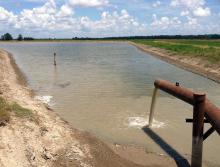Information Possibly Outdated
The information presented on this page was originally released on May 16, 2014. It may not be outdated, but please search our site for more current information. If you plan to quote or reference this information in a publication, please check with the Extension specialist or author before proceeding.
Conservation practices benefit water quality, wildlife
MISSISSIPPI STATE -- Gardening season is in full swing, and rain barrels are displayed for sale in local gardening stores. Rain barrels are systems that collect rainwater that would otherwise be lost into city sewers. The rainwater can be used to keep tomatoes, herbs and other treasured garden plants flourishing.
The Environmental Protection Agency estimates that 40 percent of total household water use during the summer is for lawn and garden watering. Rain barrels are easy ways to both conserve water and cut your water bill.
In that same way, farmers use tailwater recovery systems to collect water for irrigating crops. Tailwater recovery systems are essentially giant barrels that collect not only rainwater, but also irrigation water that drains from agriculture fields. A network of ditches adjacent to agriculture fields captures the water as it runs off. The ditches may also direct water into a storage or holding pond.
Drainage of fields is necessary for crop production, and tailwater recovery systems promote both drainage and conservation. When farmers need to irrigate, they can pump captured water rather than water from groundwater wells.
You probably know that water quality continues to be an issue in our state’s lakes and rivers. You may not be aware that water quantity is also a concern in Mississippi. Tailwater recovery systems are one tool that landowners can use to improve both water quantity and water quality.
A rain barrel is typically made out of plastic and targets only water quantity. Tailwater recovery ditches and ponds also impact water quality because they bring water into contact with the soil surface. The soil filters out harmful contaminants from the water before they flow into nearby rivers and streams.
Additionally, sediment, the tiny particles of soil that pollute the water and give the Mississippi Delta waters their brown color, sinks to the bottom when the water is held in these systems.
Farming and conservation have not always been used in the same sentence, but many Mississippi farmers are implementing conservation practices like tailwater recovery systems and showcasing how conservation and agriculture can work together. Some landowners remain apprehensive about implementing such conservation practices, and who can blame them? Implementing a tailwater recovery system can be costly, even with government cost-share programs through agencies like the U.S. Department of Agriculture Natural Resources Conservation Service.
As more landowners see the benefits of holding water on their land, word is spreading about how investments in conservation can lead to lower fuel costs for irrigation pumping and thus higher returns for a production farming operation. In other words, tailwater recovery systems are good for the bottom line in addition to being good for water quality.
Tailwater recovery systems also provide wildlife habitat. Much of the most heavily farmed areas of Mississippi, particularly in the Delta, were wetlands before they were farm fields. As more land is converted to agriculture to meet the food and fiber demands of a growing global population, more wetland habitat is lost.
Creating waterfowl habitat helps ensure that these birds keep coming back to the region and are able to survive and maintain healthy populations. The ability to provide waterfowl outfitting services -- including guides, guide services, equipment, stands, blinds, or transportation to and from the field for hunters -- on their farmlands can also be quite a lucrative pastime for landowners with wetlands or wetland-like habitats on their property.
For more information about tailwater recovery systems as well as conservation practices for agriculture, contact Beth Poganski with the R.E.A.C.H. program at 662-325-7491 or bpoganski@cfr.msstate.edu.

Editor’s Note: Extension Outdoors is a column authored by several different experts in the Mississippi State University Extension Service.






